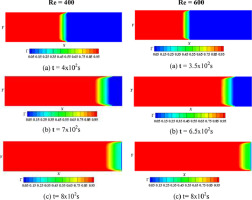当前位置:
X-MOL 学术
›
Int. J. Heat Mass Transf.
›
论文详情
Our official English website, www.x-mol.net, welcomes your feedback! (Note: you will need to create a separate account there.)
Lattice Boltzmann simulation of forced convection melting of a composite phase change material with heat dissipation through an open-ended channel
International Journal of Heat and Mass Transfer ( IF 5.2 ) Pub Date : 2020-06-01 , DOI: 10.1016/j.ijheatmasstransfer.2020.119606 R. Mabrouk , H. Dhahri , H. Naji , S. Hammouda , Z. Younsi
International Journal of Heat and Mass Transfer ( IF 5.2 ) Pub Date : 2020-06-01 , DOI: 10.1016/j.ijheatmasstransfer.2020.119606 R. Mabrouk , H. Dhahri , H. Naji , S. Hammouda , Z. Younsi

|
Abstract This paper performs a numerical analysis of time-dependent forced convection heat transfer in an open-ended straight channel filled with a metal structure and paraffin as a phase change material (PCM). The unsteady two-dimensional governing equations, based on the Darcy-Brinkmann-Forchheimer (DBF) model and the two-energy transport equations (i.e. local thermal non-equilibrium, LTNE) at the representative elementary volume (REV) scale in their dimensionless forms, have been simulated using the thermal single relaxation time (T-SRT) Lattice Boltzmann Method (LBM) with three distribution functions to handle the fluid, and temperatures of the fluid and solid phases. Effects of Reynolds number (100 ≤ Re ≤ 600), Eckert number (0 ≤ Ec ≤ 10), porosity (0.1 ≤ ɛ ≤ 0.8) on dynamic and thermal fields, entropy generation, and energy and exergy efficiencies of the considered system are examined. The relevance of these parameters is highlighted and discussed during the charging (melting) and discharging (solidifying) processes. Interestingly, it can be stated that small porosities promptly accelerate these two processes due to high thermal conductivity of the metal foam/PCM composite, and improve energy and exergy efficiencies of the system, whatever Re for the very low porosity values (0.4 and 0.6). In addition, streamlines, isotherms and melt front (phase field) are exhibited for this parameters range. Based on the findings obtained, it is concluded that, in the context of laminar forced convection melting of a composite PCM with heat dissipation in a porous PCM-filled channel, 1) there is a critical Reynolds number for which the storage energy is optimal and whose quality is improved using both the porosity and the effects of viscous dissipation, and 2) the proposed approach's potential and the in-house code flexibility implemented are demonstrated.
中文翻译:

通过开放式通道散热的复合相变材料强制对流熔化的格子 Boltzmann 模拟
摘要 本文对填充有金属结构和石蜡作为相变材料 (PCM) 的开放式直通道中的瞬态强制对流传热进行了数值分析。非定常二维控制方程,基于 Darcy-Brinkmann-Forchheimer (DBF) 模型和无量纲形式的具有代表性的基本体积 (REV) 尺度的两能量传输方程(即局部热非平衡,LTNE) ,已使用热单弛豫时间 (T-SRT) 格子玻尔兹曼方法 (LBM) 进行了模拟,该方法具有三个分布函数来处理流体以及流体和固相的温度。雷诺数 (100 ≤ Re ≤ 600)、埃克特数 (0 ≤ Ec ≤ 10)、孔隙度 (0.1 ≤ ɛ ≤ 0.8) 对动态和热场、熵生成的影响,并检查所考虑系统的能量和火用效率。在充电(熔化)和放电(凝固)过程中强调并讨论了这些参数的相关性。有趣的是,可以说,由于金属泡沫/PCM 复合材料的高热导率,小孔隙率会迅速加速这两个过程,并提高系统的能量和火用效率,无论 Re 对于极低的孔隙率值(0.4 和 0.6)如何. 此外,该参数范围还显示了流线、等温线和熔体前沿(相场)。基于获得的研究结果,得出的结论是,在复合 PCM 的层流强制对流熔化的情况下,在多孔 PCM 填充的通道中散热,
更新日期:2020-06-01
中文翻译:

通过开放式通道散热的复合相变材料强制对流熔化的格子 Boltzmann 模拟
摘要 本文对填充有金属结构和石蜡作为相变材料 (PCM) 的开放式直通道中的瞬态强制对流传热进行了数值分析。非定常二维控制方程,基于 Darcy-Brinkmann-Forchheimer (DBF) 模型和无量纲形式的具有代表性的基本体积 (REV) 尺度的两能量传输方程(即局部热非平衡,LTNE) ,已使用热单弛豫时间 (T-SRT) 格子玻尔兹曼方法 (LBM) 进行了模拟,该方法具有三个分布函数来处理流体以及流体和固相的温度。雷诺数 (100 ≤ Re ≤ 600)、埃克特数 (0 ≤ Ec ≤ 10)、孔隙度 (0.1 ≤ ɛ ≤ 0.8) 对动态和热场、熵生成的影响,并检查所考虑系统的能量和火用效率。在充电(熔化)和放电(凝固)过程中强调并讨论了这些参数的相关性。有趣的是,可以说,由于金属泡沫/PCM 复合材料的高热导率,小孔隙率会迅速加速这两个过程,并提高系统的能量和火用效率,无论 Re 对于极低的孔隙率值(0.4 和 0.6)如何. 此外,该参数范围还显示了流线、等温线和熔体前沿(相场)。基于获得的研究结果,得出的结论是,在复合 PCM 的层流强制对流熔化的情况下,在多孔 PCM 填充的通道中散热,



























 京公网安备 11010802027423号
京公网安备 11010802027423号